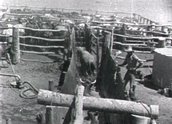

Australia (1934)
Synopsis
Semi-professional filmmaker Gordon Donkin, accompanied by his wife, travelled more than 25,000 kilometres over 18 months filming throughout Australia. The resulting documentary presents a comprehensive and realistic picture of life and work in 1930s Australia with an emphasis on the farming and cattle industries.
Curator’s notes
In Australia, Gordon Donkin covers a subject close to his heart – the man on the land. Donkin himself was born and bred in the country, coming from a family of graziers and pastoralists in New South Wales. His great-grandfather, John Busby, emigrated from England and was contracted to construct the first regular water supply for Sydney. As well as a familiarity with Australia’s outback, Donkin also had a great curiosity for other cultures and a strong sense of adventure. By the time he made this film – his most accomplished and widely exhibited – he had travelled abroad extensively, visiting Asia, eastern Europe, Africa and South America. He recorded his travels with a 16mm camera and also photographed them. Several glass plate slides are held at the National Film and Sound Archive and the National Library of Australia. Donkin had an interest in natural history, collected specimens in Africa for the Australian Museum and was a member of the Royal Geographical Society.
With Australia, Donkin’s intention was not to make a documentary about his country for himself, but to educate and inform people abroad about Australia. Donkin toured the film to London where he screened it to hundreds of people from schools, training colleges and the general public. It also had a private screening in Sydney. It was accompanied by his own commentary – something he had previously done in Africa for one of his earlier productions. From all accounts, Australia was well received by audiences – there were even favourable write-ups in the London newspapers The Times and The Daily Telegraph.
While we don’t know how Donkin would have narrated the film, maps and intertitles locate the region and identify each industry as the documentary unfolds. His camera is steady and he uses a combination of still and slow panning shots. His familiarity with the land and Australia’s primary industries makes the film an accomplished survey of rural 1930s Australia, but he also documents outback sporting and recreational activities, and educational and medical facilities, as well as including more unusual scenes like a man boxing a kangaroo (probably for its novelty value for British audiences).
- Overview
- Curator’s notes
- Video 2 clips
- Principal credits
- Find a copy
- Make a comment
- Add your review



